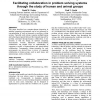Free Online Productivity Tools
i2Speak
i2Symbol
i2OCR
iTex2Img
iWeb2Print
iWeb2Shot
i2Type
iPdf2Split
iPdf2Merge
i2Bopomofo
i2Arabic
i2Style
i2Image
i2PDF
iLatex2Rtf
Sci2ools
NORDICHI
2004
ACM
2004
ACM
Wolves, football, and ambient computing: facilitating collaboration in problem solving systems through the study of human and an
This paper describes how computer-human interaction in ambient computing environments can be best informed by conceptualizing of such environments as problem solving systems. Typically, such systems comprise multiple human and technological agents that meet the demands imposed by problem constraints through dynamic collaboration. A key assertion is that the design of ambient computing environments towards efficacious human-machine collaboration can benefit from an understanding of competence models of human-human and animal-animal collaboration. Consequently, design principles for such environments are derived from a review of competent collaboration in human groups, such as sport teams, and animal groups, such as wolf packs. Author Keywords Ambient computing, collaboration, computer-human interaction, pervasive computing, problem solving. ACM Classification Keywords H.5.m. Information Interfaces and Presentation (e.g., HCI): Miscellaneous.
| Added | 30 Jun 2010 |
| Updated | 30 Jun 2010 |
| Type | Conference |
| Year | 2004 |
| Where | NORDICHI |
| Authors | David W. Eccles, Paul T. Groth |
Comments (0)

